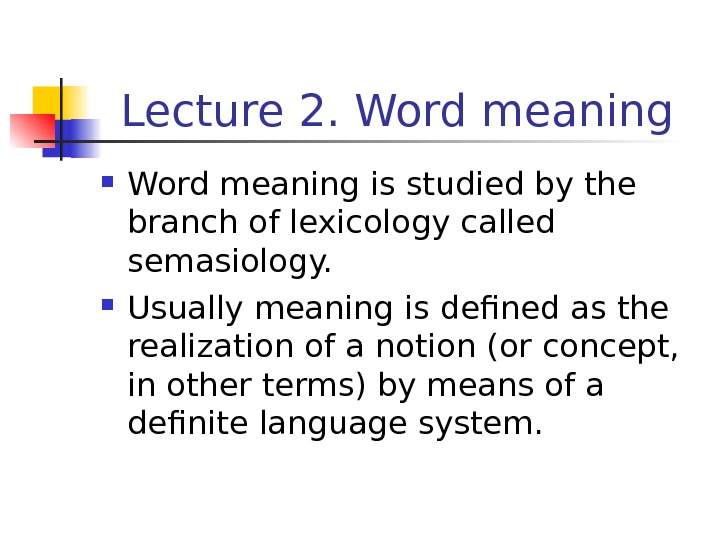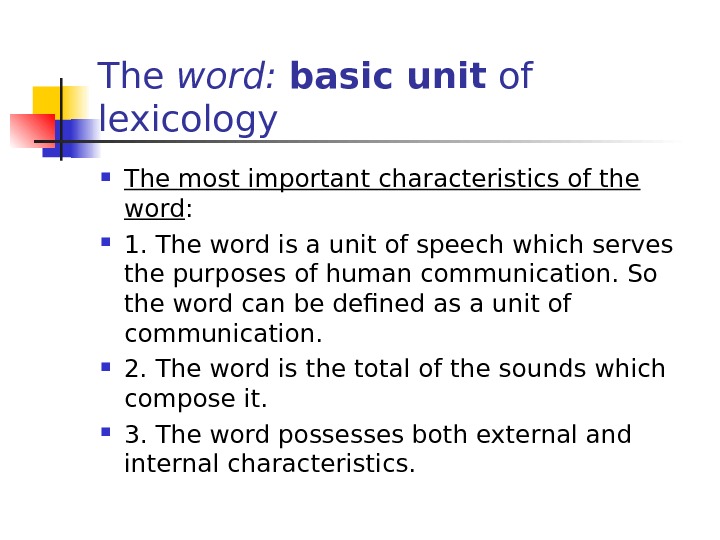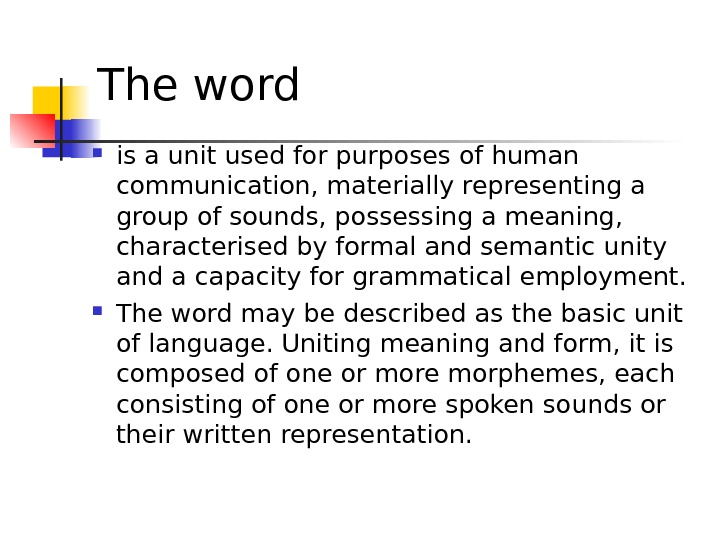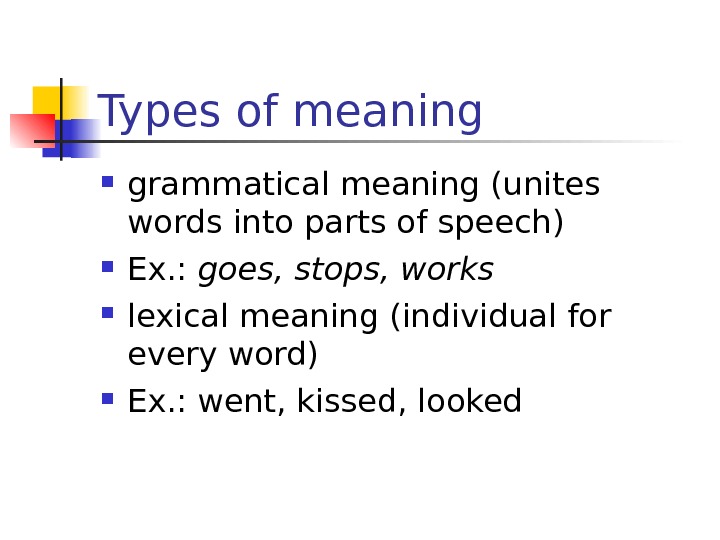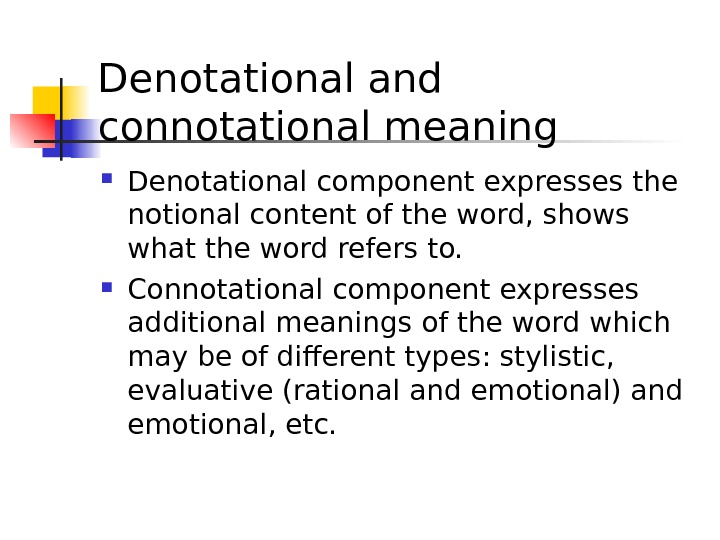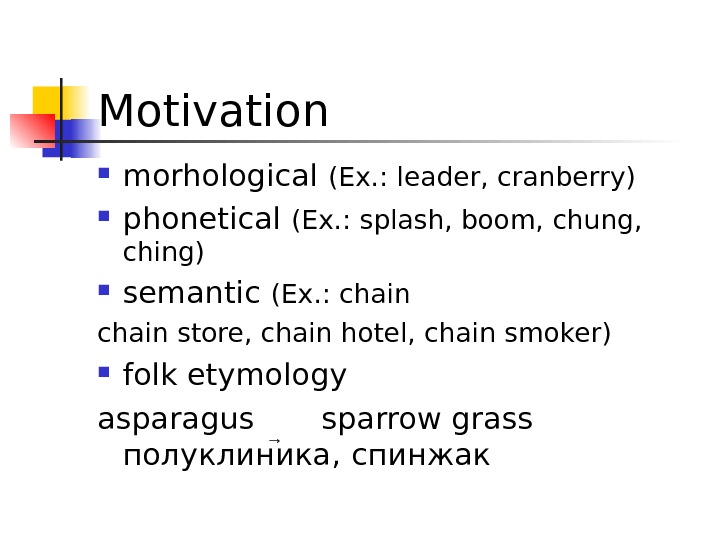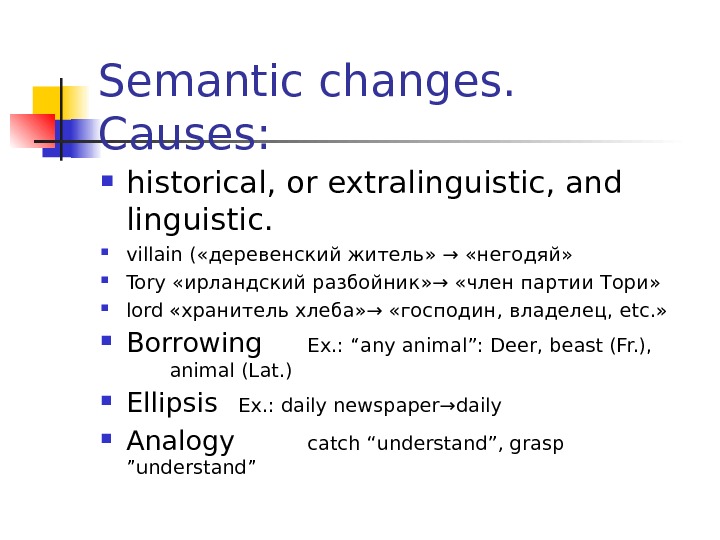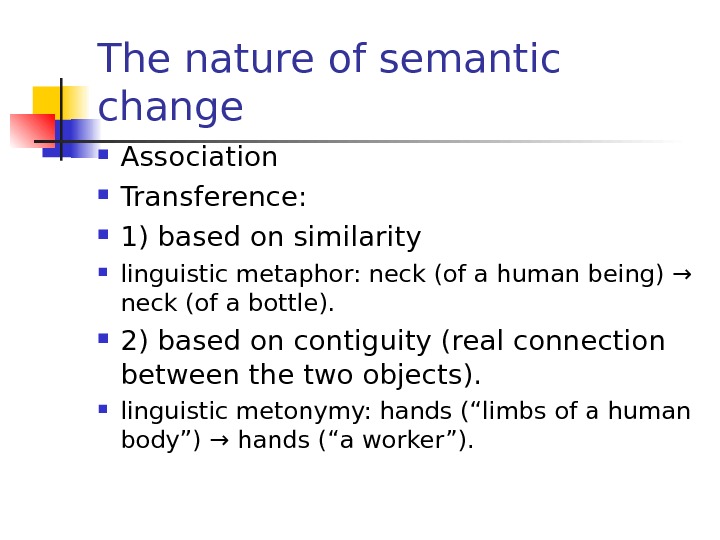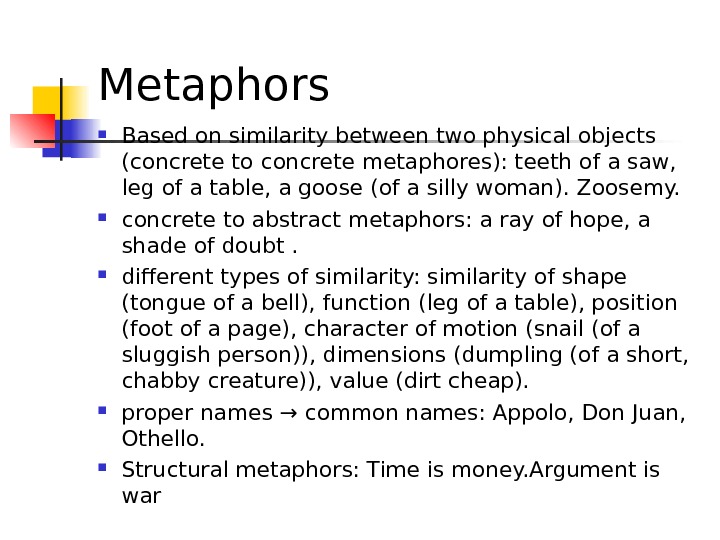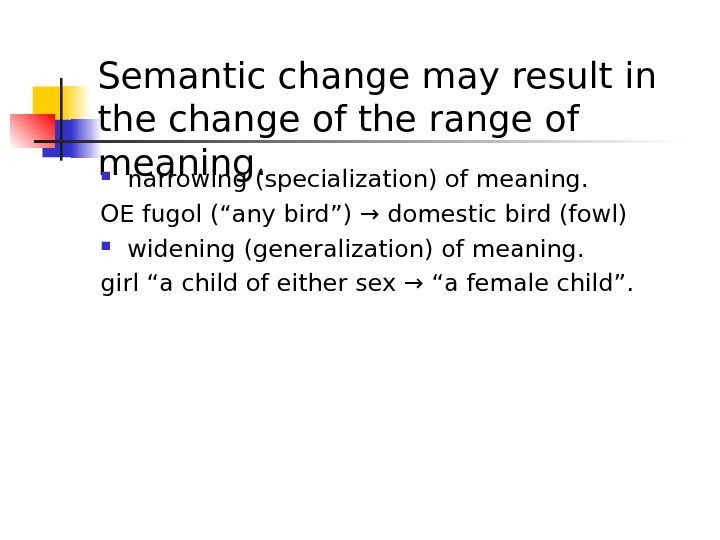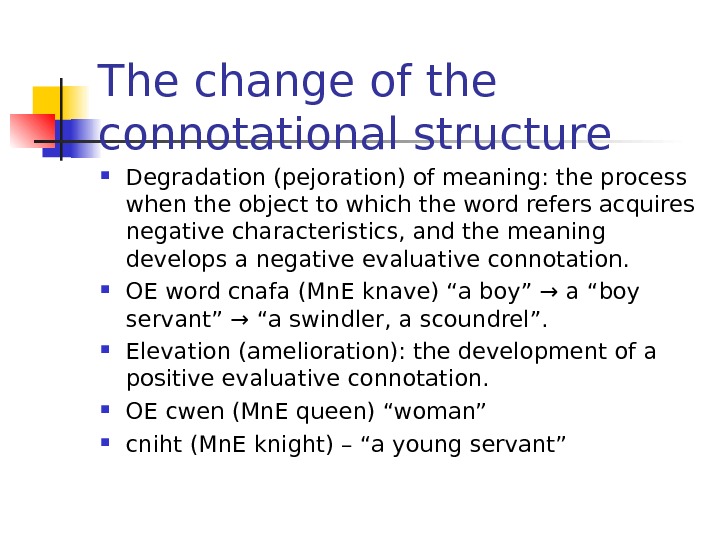The present course
concentrates on the following aspects of English lexicology:
1)
Semasiology or semantics, including the semantic classification of
English words;
2) The
study of word-structure and word-formation;
3) The
study of word-equivalents, or idioms and phraseological units;
4) A brief
etymological survey of the English word-stock;
5)
Fundamentals of English lexicography.
Let us now
take each of these subjects in more detail.
1)
Semasiology
is the branch of lexicology devoted to the study of meaning.
Its name comes from the Greek «semantikos» which means
«significant». In English-speaking countries, this field of
linguistic study is also known as semantics which is less precise,
since the word «semantics» may also be used as a synonym
for «meaning» – we can, for example, speak of the
«semantics of a word». Semasiology may use both the
synchronic and diachronic approaches to the study of meaning. In the
first case, it studies types of meaning found in present-day
English, providing a classification of English words according to
their meaning; in the second case, it deals with changes
that the meanings of words undergo in the course of the development
of the language.
Semasiology
is closely connected with another branch of linguistics, onomasiology
(from the Greek «onoma» – «name»), which also
studies meaning but from, as it were, the direction opposite to
semasiology. While semasiology proceeds from the word to its meaning,
onomasiology proceeds from the object of naming to its name, i.e. it
studies the ways in which things are named in a language. (Another
name for onomasiology, much used by Soviet linguists in the recent
past, is the «theory of nomination».) Proper names – i.e.
names of people, geographical names – are studied by the branch of
onomasiology called onomastics.
Both onomasiology and onomastics are highly specialized branches of
lexicology and therefore outside the scope of the present course.
2)
Word-structure
and word-formation
in English are studied by a branch of lexicology known as
word-building,
which studies both the formation of new words and the structure of
the existing ones. Word building investigates: how new words are
formed; how they are related to the existing ones; what material they
are made of (including the typical word-production patterns and
components, as well as a study of their productivity).
There’s
no unity of opinion among linguists whether word-building should be
considered under lexicology or grammar (as morphology), since in many
cases it is the syntactic properties of the words, not their
structure, that determine their functioning in the language. In
Chinese, for example, it is very hard to tell a word from a morpheme,
as Chinese is an analytical language. In English, which also has
analytic tendencies, a word may start functioning as a different part
of speech without any apparent changes in its morphological
structure, by changing its syntactical distribution alone. This is
known as conversion
and will be discussed in detail later.
3)
Word-equivalents
in English, i.e. units of language that seem to consist of several
words but function as
an inseparable unity, are studied by a branch of lexicology called
phraseology.
To these belong idioms,
set
expressions,
phraseological
unities
and other traditional units in the vocabulary. The meaning of such a
unit is not usually the sum of the meanings of its parts; thus a
white elephant
need not be either white or an elephant, but is anything hard to keep
and harder to get rid of. Neither is a
red herring
a fish or red, but is something used to deceive, or distract
attention from what is really important. For obvious reasons, this
aspect of the language gets less attention from native linguists than
from foreign learners. Phraseology studies the classification of
phraseological units, their structure, origin and use in the
language.
4) The
origin and history of words in English is studied by a branch of
lexicology called etymology
(from the Greek «etymon», meaning «the truth»).
Originally it set forth to determine the «true» or
«original» meanings of words, uncorrupted by later use. At
present it mainly deals with motivations
of words, tracing their use back to the earliest known forma and
meanings. Etymology may be thus compared to archaeology: both try to
reconstruct the past by its surviving fragments. Apart from that,
etymology investigates borrowing
of
words (source language, method of borrowing, relation to native
words, etc.). The approach it uses is of necessity diachronic.
5)
Lexicography
(from the Greek «lexicon», meaning «a dictionary»,
and «grapho» – «to write») is perhaps the most
important branch of applied lexicology, dealing with the theory and
practice of compiling dictionaries. It studies, among other things,
the classification of dictionaries, their structure and general
principles of dictionary-making.
Соседние файлы в предмете [НЕСОРТИРОВАННОЕ]
- #
- #
- #
- #
- #
- #
- #
- #
- #
- #
- #
From Wikipedia, the free encyclopedia
Lexicology is the branch of linguistics that analyzes the lexicon of a specific language. A word is the smallest meaningful unit of a language that can stand on its own, and is made up of small components called morphemes and even smaller elements known as phonemes, or distinguishing sounds. Lexicology examines every feature of a word – including formation, spelling, origin, usage, and definition.[1]
Lexicology also considers the relationships that exist between words. In linguistics, the lexicon of a language is composed of lexemes, which are abstract units of meaning that correspond to a set of related forms of a word. Lexicology looks at how words can be broken down as well as identifies common patterns they follow.[2]
Lexicology is associated with lexicography, which is the practice of compiling dictionaries.[3]
Etymology[edit]
The term lexicology derives from the Greek word λεξικόν lexicon (neuter of λεξικός lexikos, «of or for words»,[4] from λέξις lexis, «speech» or «word»[5]) and -λογία -logia, «the study of» (a suffix derived from λόγος logos, amongst others meaning «learning, reasoning, explanation, subject-matter»).[6]
Etymology as a science is actually a focus of lexicology. Since lexicology studies the meaning of words and their semantic relations, it often explores the history and development of a word. Etymologists analyze related languages using the comparative method, which is a set of techniques that allow linguists to recover the ancestral phonological, morphological, syntactic, etc., components of modern languages by comparing their cognate material.[7] This means many word roots from different branches of the Indo-European language family can be traced back to single words from the Proto-Indo-European language. The English language, for instance, contains more borrowed words (or loan words) in its vocabulary than native words.[8] Examples include parkour from French, karaoke from Japanese, coconut from Portuguese, mango from Hindi, etc. A lot of music terminology, like piano, solo, and opera, is borrowed from Italian. These words can be further classified according to the linguistic element that is borrowed: phonemes, morphemes, and semantics.[7]
Approach[edit]
General lexicology is the broad study of words regardless of a language’s specific properties. It is concerned with linguistic features that are common among all languages, such as phonemes and morphemes. Special lexicology, on the other hand, looks at what a particular language contributes to its vocabulary, such as grammars.[2] Altogether lexicological studies can be approached two ways:
- Diachronic or historical lexicology is devoted to the evolution of words and word-formation over time. It investigates the origins of a word and the ways in which its structure, meaning, and usage have since changed.[9]
- Synchronic or descriptive lexicology examines the words of a language within a certain time frame. This could be a period during the language’s early stages of development, its current state, or any given interval in between.[10]
These complementary perspectives were proposed by Swiss linguist Ferdinand de Saussure.[10] Lexicology can have both comparative and contrastive methodologies. Comparative lexicology searches for similar features that are shared among two or more languages. Contrastive lexicology identifies the linguistic characteristics which distinguish between related and unrelated languages.[9]
Semantics[edit]
The subfield of semantics that pertains especially to lexicological work is called lexical semantics. In brief, lexical semantics contemplates the significance of words and their meanings through several lenses, including synonymy, antonymy, hyponymy, and polysemy, among others. Semantic analysis of lexical material may involve both the contextualization of the word(s) and syntactic ambiguity. Semasiology and onomasiology are relevant linguistic disciplines associated with lexical semantics.[9]
A word can have two kinds of meaning: grammatical and lexical. Grammatical meaning refers to a word’s function in a language, such as tense or plurality, which can be deduced from affixes. Lexical meaning is not limited to a single form of a word, but rather what the word denotes as a base word. For example, the verb to walk can become walks, walked, and walking – each word has a different grammatical meaning, but the same lexical meaning («to move one’s feet at a regular pace»).[11]
Phraseology[edit]
Another focus of lexicology is phraseology, which studies multi-word expressions, or idioms, like ‘raining cats and dogs.’ The meaning of the phrase as a whole has a different meaning than each word does on its own and is often unpredictable when considering its components individually. Phraseology examines how and why such meanings exist, and analyzes the laws that govern these word combinations.[12]
Idioms and other phraseological units can be classified according to content and/ or meaning. They are difficult to translate word-for-word from one language to another.[13]
Lexicography[edit]
Lexicography is the study of lexicons, and is divided into two separate academic disciplines. It is the art of compiling dictionaries.[14]
- Practical lexicography is the art or craft of compiling, writing and editing dictionaries.
- Theoretical lexicography is the scholarly study of semantic, orthographic, syntagmatic and paradigmatic features of lexemes of the lexicon (vocabulary) of a language, developing theories of dictionary components and structures linking the data in dictionaries, the needs for information by users in specific types of situations, and how users may best access the data incorporated in printed and electronic dictionaries. This is sometimes referred to as ‘metalexicography’.
There is some disagreement on the definition of lexicology, as distinct from lexicography. Some use «lexicology» as a synonym for theoretical lexicography; others use it to mean a branch of linguistics pertaining to the inventory of words in a particular language.
Lexicologists[edit]
- Dámaso Alonso (October 22, 1898 — January 25, 1990): Spanish poet, literary critic, and philologist
- Roland Barthes (November 12, 1915 — March 25, 1980): French writer, critic, and semiotician
- Ghil’ad Zuckermann (born June 1, 1971): Israeli linguist and language revivalist
See also[edit]
- Calque
- Computational lexicology
- Lexicostatistics
- Lexical semantics
- Lexical analysis
- English lexicology and lexicography
- List of lexicographers
- List of linguists
- Lexical Markup Framework
References[edit]
- ^ Babich, Galina Nikolaevna (2016). Lexicology : a current guide = Lexicologia angliskogo yazyka (8 ed.). Moscow: Flinta. p. 1. ISBN 978-5-9765-0249-9. OCLC 934368509.
- ^ a b Dzharasova, T. T. (2020). English lexicology and lexicography : theory and practice (2 ed.). Almaty: Al-Farabi Kazakh National University. pp. 4–5. ISBN 978-601-04-0595-0.
- ^ Babich, Galina Nikolaevna (2016). Lexicology : a current guide = Lexicologia angliskogo yazyka (8 ed.). Moscow: Flinta. p. 133. ISBN 978-5-9765-0249-9. OCLC 934368509.
- ^ λεξικός, Henry George Liddell, Robert Scott, A Greek–English Lexicon, on Perseus Digital Library
- ^ λέξις, Henry George Liddell, Robert Scott, A Greek–English Lexicon, on Perseus Digital Library
- ^ λόγος, Henry George Liddell, Robert Scott, A Greek–English Lexicon, on Perseus Digital Library
- ^ a b Joseph, Brian D.; Janda, Richard D., eds. (2003), «The Handbook of Historical Linguistics», The Handbook of Historical Linguistics, Oxford, UK: Blackwell Publishing Ltd, p. 183, ISBN 9780631195719
- ^ Babich, Galina Nikolaevna (2016). Lexicology : a current guide = Lexicologia angliskogo yazyka (8 ed.). Moscow: Flinta. pp. 20–23. ISBN 978-5-9765-0249-9. OCLC 934368509.
- ^ a b c Popescu, Floriana (2019). A paradigm of comparative lexicology. Newcastle: Cambridge Scholars Publishing. pp. 19–20. ISBN 1-5275-1808-6. OCLC 1063709395.
- ^ a b Halliday, M. A. K. (2007). Lexicology : a short introduction. Colin Yallop. London: Continuum. pp. 56–57. ISBN 978-1-4411-5054-7. OCLC 741690096.
- ^ Dzharasova, T. T. (2020). English lexicology and lexicography : theory and practice (2 ed.). Almaty: Al-Farabi Kazakh National University. p. 41. ISBN 978-601-04-0595-0.
- ^ Halliday, M. A. K. (2007). Lexicology : a short introduction. Colin Yallop. London: Continuum. pp. 12–13. ISBN 978-1-4411-5054-7. OCLC 741690096.
- ^ Dzharasova, T. T. (2020). English lexicology and lexicography : theory and practice (2 ed.). Almaty: Al-Farabi Kazakh National University. pp. 75–76. ISBN 978-601-04-0595-0.
- ^ Jackson, Howard (2017-10-02), «English lexicography in the Internet era», The Routledge Handbook of Lexicography, Routledge, pp. 540–553, doi:10.4324/9781315104942-34, ISBN 978-1-315-10494-2, retrieved 2022-09-16
External links[edit]
Look up lexicology in Wiktionary, the free dictionary.
Wikimedia Commons has media related to Lexicology.
Societies[edit]
- Association for Automatic Language Processing (ATALA), Paris, France
- International Society for Historical Lexicography and Lexicology, University of Leicester
Theory[edit]
- Lexicology vs. lexicography – an explanation
- Lexicography, lexicology, lexicon theory
Glossary[edit]
- ‘L’ entries (from lexeme to lexicon) at SIL (Summer Institute of Linguistics)’s glossary of linguistic terms
Teaching material[edit]
- English and General Historical Lexicology (by Joachim Grzega and Marion Schöner
Journals[edit]
- Lexis, E-Journal in English Lexicology (by Denis Jamet)
3.1. The object of semasiology. Two approaches to the study of meaning.
3.2. Types of meaning.
3.3. Meaning and motivation.
3.1. The branch of lexicology which studies meaning is called » semasiology «. Sometimes the term » semantics » is used as a synonym to semasiology, but it is ambiguous as it can stand as well for (1) the expressive aspect of language in general and (2) the meaning of one particular word.
Meaning is certainly the most important property of the word but what is » meaning»?
Meaning is one of the most controversial terms in lexicology. At present there is no generally accepted definition of meaning. Prof. Smirnitsky defines meaning as » a certain reflection in the mind of objects, phenomena or relations that makes part of the linguistic sign, its so-called inner facet, whereas the sound form functions as its outer facet». Generally speaking, meaning can be described as a component of the word through which a concept is communicated, enabling the word to denote objects in the real world.
There are two approaches to the study of meaning: the referential approach and the functional approach. The former tries to define meaning in terms of relations between the word (sound form), concept (notion, thought) and referent (object which the word denotes). They are closely connected and the relationship between them is represented by » the semiotic triangle» (= the basic triangle) of Ogden and Richards (in the book » The Meaning of Meaning» (1923) by O.K. Ogden and I.A. Richards).


 |
symbol referent
(sound form)
This view denies a direct link between words and things, arguing that the relationship can be made only through the use of our minds. Meaning is related to a sound form, concept and referent but not identical with them: meaning is a linguistic phenomenon while neither concept nor referent is.
The main criticism of this approach is the difficulty of identifying » concepts»: they are mental phenomena and purely subjective, existing in the minds of individuals. The strongest point of this approach is that it connects meaning and the process of nomination.
The functional approach to meaning is less concerned with what meaning is than with how it works. It is argued, to say that » words have meanings» means only that they are used in a certain way in a sentence. There is no meaning beyond that. Ludwig Wittgenstein (1889-1951), in particular, stressed the importance of this approach in his dictum: » The meaning of the word is its use in the language». So meaning is studied by making detailed analyses of the way words are used in contexts, through their relations to other words in speech, and not through their relations to concepts or referents.
Actually, the functional approach is basically confined to the analysis of sameness or difference of meaning. For example, we can say that in » take the bottle » and » take to the bottle » take has different meaning as it is used differently, but it does not explain what the meaning of the verb is. So the functional approach should be used not as the theoretical basis for the study of meaning, but only as complementary to the referential approach.
3.2. Word meaning is made up of different components, commonly known as types of meaning. The two main types of meaning are grammatical meaning and lexical meaning.
Grammatical meaning belongs to sets of word-forms and is common to all words of the given part of speech,
e.g. girls, boys, classes, children, mice express the meaning of » plurality».
Lexical meaning belongs to an individual word in all its forms. It comprises several components. The two main ones are the denotational component and the connotational component.
The denotational (= denotative) component, also called » referential meaning» or » cognitive meaning», expresses the conceptual (notional) content of a word; broadly, it is some information, or knowledge, of the real-world object that the word denotes. Basically, this is the component that makes communication possible.
e.g. notorious » widely-known», celebrated » known widely».
The connotational (connotative) component expresses the attitude of the speaker to what he is saying, to the object denoted by the word. This component consists of emotive connotation and evaluative connotation.
1) Emotive connotation (= » affective meaning», or an emotive charge),
e.g. In » a single tree » single states that there is only one tree, but » a lonely tree » besides giving the same information, also renders (conveys) the feeling of sadness.
We shouldn’t confuse emotive connotations and emotive denotative meanings in which some emotion is named, e.g. horror, love, fear, etc.
2) Evaluative connotation labels the referent as » good» or » bad»,
e.g. notorious has a negative evaluative connotation, while celebrated a positive one. Cf.: a notorious criminal/liar/ coward, etc. and a celebrated singer/ scholar/ artist, etc.
It should be noted that emotive and evaluative connotations are not individual, they are common to all speakers of the language. But emotive implications are individual (or common to a group of speakers), subjective, depend on personal experience.
e.g. The word » hospital » may evoke all kinds of emotions in different people (an architect, a doctor, an invalid, etc.)
Stylistic connotation, or stylistic reference, another component of word meaning, stands somewhat apart from emotive and evaluative connotations. Indeed, it does not characterize a referent, but rather states how a word should be used by referring it to a certain functional style of the language peculiar to a specific sphere of communication. It shows in what social context, in what communicative situations the word can be used.
Stylistically, words can be roughly classified into literary, or formal (e.g. commence, discharge, parent), neutral (e.g. father, begin, dismiss) and non-literary, or informal (e.g. dad, sack, set off).
3.3. The term » motivation » is used to denote the relationship between the form of the word, i.e. its sound form, morphemic composition and structural pattern, and its meaning.
There are three main types of motivation: phonetic, morphological and semantic.
1) Phonetic motivation is a direct connection between the sound form of a word and its meaning. There are two types of phonetic motivation: sound imitation and sound symbolism.
a) Sound imitation, or onomatopoeia: phonetically motivated words are a direct imitation of the sounds they denote (or the sounds produced by actions or objects they denote),
e.g. buzz, swish, bang, thud, cuckoo.
b) Sound symbolism. It’s argued by some linguists that the sounds that make up a word may reflect or symbolise the properties of the object which the word refers to, i.e. they may suggest size, shape, speed, colour, etc.
e.g. back vowels suggest big size, heavy weight, dark colour, front vowels suggest lightness, smallness, etc.
Many words beginning with sl- are slippery in some way: slide, slip, slither, sludge, etc. or pejorative: slut, slattern, sly, sloppy, slovenly; words that end in -ump almost all refer to some kind of roundish mass: plump, chump, rump, hump, stump.
Certainly, not every word with these phonetic characteristics will have the meaning suggested. This is, perhaps, one of the reasons why sound symbolism is not universally recognized in linguistics.
2) Morphological motivation is a direct connection between the lexical meaning of the component morphemes, the pattern of their arrangement and the meaning of the word.
Morphologically motivated words are those whose meaning is determined by the meaning of their components,
e.g. re-write » write again», ex-wife » former wife».
The degree of morphological motivation may be different. Words may be fully motivated (then they are transparent), partially motivated and non-motivated (idiomatic, or opaque).
a) If the meaning of the word is determined by the meaning of the components and the structural pattern, it is fully motivated: e.g. hatless.
b) If the connection between the morphemic composition of a word and its meaning is arbitrary, the word is non-motivated, e.g. buttercup » yellow-flowered plant».
c) In hammer -er shows that it is an instrument, but what is » hamming «? » Ham » has no lexical meaning in this word, thus the word is partially motivated. Cf. also cranberry.
Motivation may be lost in the course of time,
e.g. in OE wī fman was motivated morphologically: wī f + man » wife of a man»; now it is opaque; its motivation is said to be faded (woman).
3) Semantic motivation is based on co-existence of direct and figurative meanings of the same word,
e.g. butterfly – 1) insect; 2) showy and frivolous person.(= metaphorical extension of the direct meaning).
|
Расчетные и графические задания Равновесный объем — это объем, определяемый равенством спроса и предложения… |
Кардиналистский и ординалистский подходы Кардиналистский (количественный подход) к анализу полезности основан на представлении о возможности измерения различных благ в условных единицах полезности… |
Обзор компонентов Multisim Компоненты – это основа любой схемы, это все элементы, из которых она состоит. Multisim оперирует с двумя категориями… |
Композиция из абстрактных геометрических фигур Данная композиция состоит из линий, штриховки, абстрактных геометрических форм… |
|
Оценка качества Анализ документации. Имеющийся рецепт, паспорт письменного контроля и номер лекарственной формы соответствуют друг другу. Ингредиенты совместимы, расчеты сделаны верно, паспорт письменного контроля выписан верно. Правильность упаковки и оформления…. БИОХИМИЯ ТКАНЕЙ ЗУБА В составе зуба выделяют минерализованные и неминерализованные ткани… Типология суицида. Феномен суицида (самоубийство или попытка самоубийства) чаще всего связывается с представлением о психологическом кризисе личности… |
- Размер: 250 Кб
- Количество слайдов: 17
